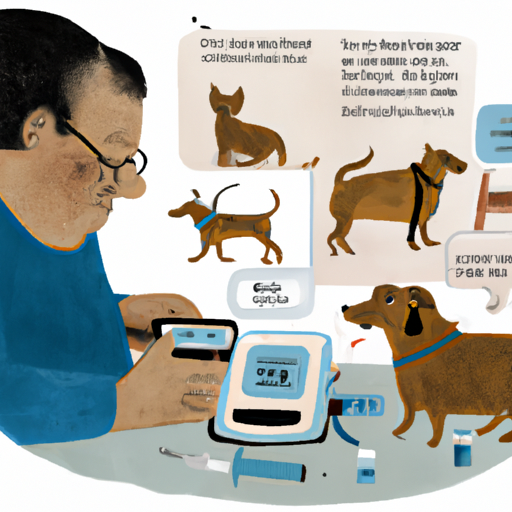Diabetes is a condition frequently seen in humans but it’s also a common diagnosis for our furry friends. Affecting approximately 1 in every 500 dogs, the disease is just as serious in pets as it is in people. The good news is, with proper diagnosis and management, our canine companions can continue to live healthy, happy lives. Let’s delve into understanding how to diagnose diabetes in dogs.
Table of Contents
- Understanding Diabetes in Dogs
- Symptoms of Diabetes in Dogs
- How to Diagnose Diabetes in Dogs
- The Diagnostic Process
- Managing Diabetes in Dogs
- Frequently Asked Questions
Key Takeaways
- Diabetes in dogs is a common and manageable disease.
- Symptoms may vary, but common signs include increased thirst, frequent urination, and unexplained weight loss.
- A diagnosis is made based on clinical signs and laboratory test results.
- Diabetes management involves a combination of diet, exercise, and insulin therapy.
- Regular check-ups and blood glucose monitoring are crucial for managing the disease.
Understanding Diabetes in Dogs
Diabetes, specifically diabetes mellitus, is a chronic disorder where the body fails to regulate blood sugar levels due to a lack of insulin or insulin resistance. This condition can lead to several health complications if not caught early and managed properly. You can learn more about the disease here.
There are two types of diabetes that can affect dogs: Type I and Type II. Type I diabetes is the most common type seen in dogs. It occurs when the body doesn’t produce enough insulin. Type II diabetes, which is less common in dogs, occurs when the body becomes resistant to insulin.
Symptoms of Diabetes in Dogs
The symptoms of diabetes in dogs can vary and may be subtle at first. Common signs include:
- Increased thirst and urination: Your dog may start to drink more water than usual and need to go outside more often.
- Unexplained weight loss: Despite eating normal or increased amounts of food, your dog may lose weight.
- Increased appetite: Even though they are eating more, they may still seem hungry all the time.
- Lethargy: A diabetic dog may appear tired and less playful.
Remember, these symptoms aren’t definitive proof of diabetes; they could indicate other health issues. Only a vet can diagnose diabetes.
How to Diagnose Diabetes in Dogs
A diagnosis of diabetes in dogs involves a series of laboratory tests. If your vet suspects diabetes, they will likely recommend blood tests and a urinalysis.
The blood tests will check for high blood glucose levels, which is a hallmark sign of diabetes. The urinalysis is used to check for glucose or ketones in the urine, another indication of diabetes.
The vet may also recommend additional tests to rule out other diseases or to check for any complications associated with diabetes. These might include a blood pressure check or a test for Cushing’s disease, which can mimic some of the symptoms of diabetes.
The Diagnostic Process
To help you understand the process, let’s break it down into a series of steps:
-
Clinical signs: The first step in diagnosing diabetes is noticing the symptoms. If you observe any changes in your dog’s behavior, eating and drinking habits, or overall health, it’s time to consult your vet.
-
Veterinary consultation: Your vet will perform a physical examination and discuss your pet’s symptoms and medical history.
-
Laboratory tests: If diabetes is suspected, your vet will recommend blood and urine tests to check for high sugar levels.
-
Additional tests: To rule out other conditions or assess any complications, further testing may be necessary.
-
Diagnosis: If the test results confirm high blood sugar levels and other signs consistent with diabetes, your vet will diagnose your pet with diabetes.
-
Treatment plan: Once a diagnosis is made, your vet will develop a treatment plan tailored to your pet’s needs.
You can find more information about the diagnostic process here.
Managing Diabetes in Dogs
Once diagnosed, your dog’s diabetes will need to be managed through a combination of diet, exercise, and insulin therapy.
Diet: A diet high in fiber and complex carbohydrates can help control your dog’s blood sugar levels. Your vet may recommend a prescription diet designed specifically for diabetic dogs.
Exercise: Regular, moderate exercise can help regulate your dog’s blood sugar levels. However, the activity should be consistent, as sudden changes can affect blood sugar levels.
Insulin Therapy: Most diabetic dogs require insulin injections, which you will need to administer at home. Your vet will guide you on how to do this.
For more insights into managing diabetes in dogs, check out this article on OneTopDog.
Frequently Asked Questions
1. Can diabetes in dogs be cured?
No, diabetes can’t be cured but it can be managed with proper care and treatment. With regular monitoring and appropriate treatment, dogs with diabetes can live a good quality life.
2. What breeds are prone to diabetes?
While any breed can develop diabetes, it’s more common in certain breeds like the Samoyed, Miniature Schnauzer, and Toy Poodle.
3. Can diabetes in dogs be prevented?
While there’s no guaranteed way to prevent diabetes, maintaining a healthy weight through a balanced diet and regular exercise can reduce the risk.
In conclusion, while a diabetes diagnosis can be daunting, remember that you’re not alone in this journey. With the right care, your pet can continue to live a happy, fulfilling life. For more resources on diabetes in dogs, check out these articles on OneTopDog and OneTopDog.



